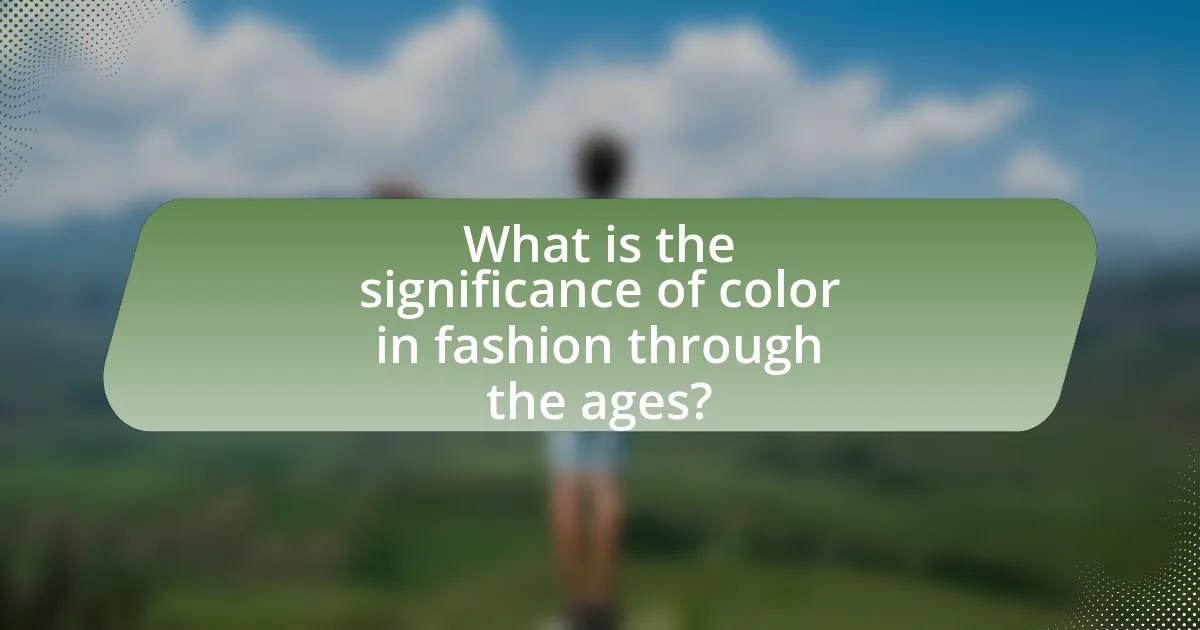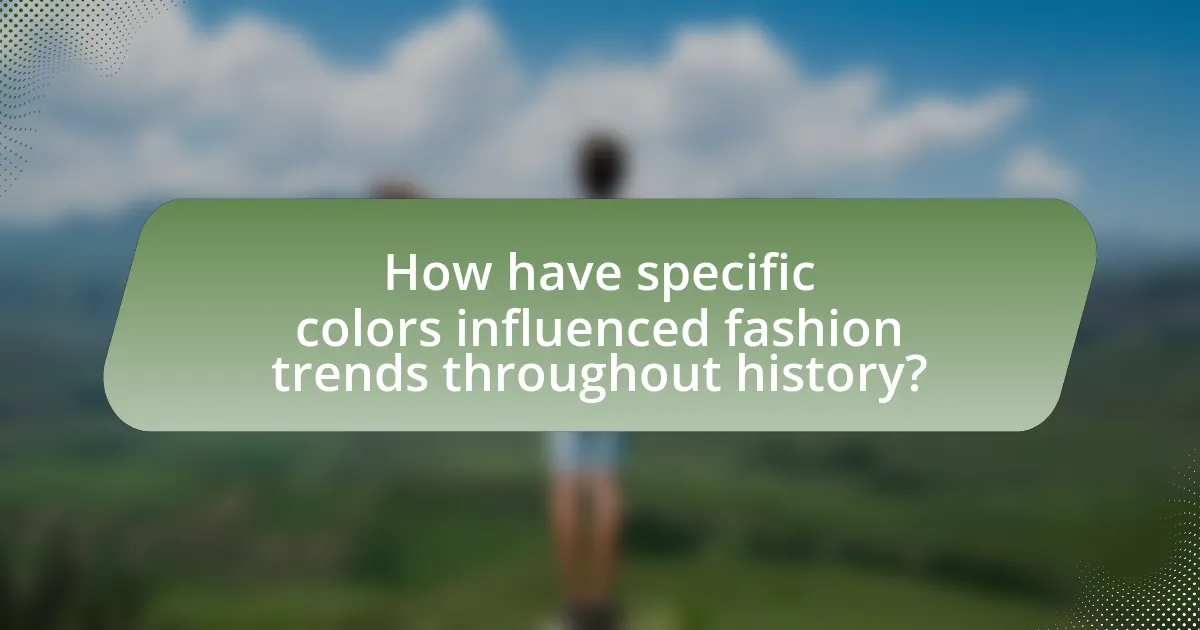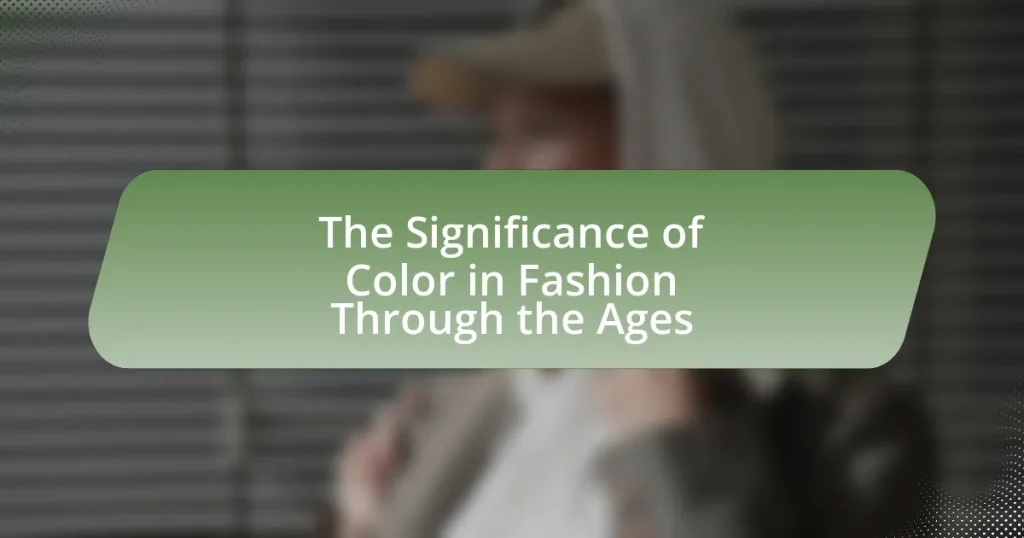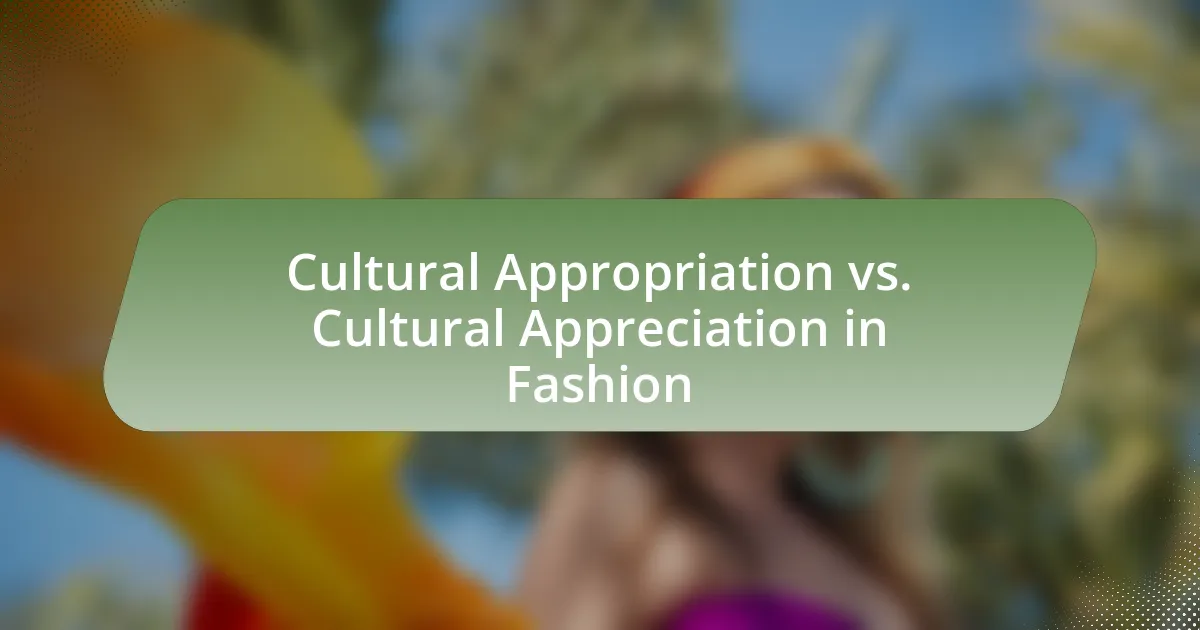The article examines the significance of color in fashion throughout history, highlighting its role as a means of expression and social signaling. It discusses how color associations have evolved, influenced by cultural movements, historical events, and technological advancements, such as the introduction of synthetic dyes. The article also explores the psychological effects of color on consumer behavior, the importance of color in fashion marketing, and the challenges designers face in color selection. Additionally, it addresses contemporary trends in color usage, the impact of sustainability, and practical tips for individuals to enhance their personal style through informed color choices.

What is the significance of color in fashion through the ages?
Color in fashion has served as a powerful means of expression and social signaling throughout history. Different colors have been associated with specific meanings, cultural significance, and social status; for example, purple was historically linked to royalty due to the rarity and expense of purple dye in ancient times. In the 19th century, the introduction of synthetic dyes expanded the color palette available to designers, allowing for greater creativity and expression in fashion. Additionally, color trends have evolved, reflecting societal changes, such as the rise of pastel colors in the 1920s symbolizing a break from traditional norms. Overall, color in fashion not only enhances aesthetic appeal but also communicates identity, mood, and cultural values across different eras.
How has the perception of color in fashion evolved over time?
The perception of color in fashion has evolved significantly from the use of natural dyes in ancient civilizations to the vibrant synthetic colors of modern times. In ancient Egypt, for instance, colors like blue and gold symbolized wealth and divinity, while during the Middle Ages, muted tones reflected social status and morality. The Industrial Revolution introduced mass production, allowing for a wider palette and accessibility, which shifted color perception towards personal expression. In the 20th century, movements like the Bauhaus and the rise of street fashion further democratized color use, emphasizing individuality and cultural identity. Today, color in fashion is often associated with trends, psychological effects, and sustainability, reflecting a complex interplay between societal values and personal choice.
What historical events influenced color trends in fashion?
Historical events such as the Industrial Revolution, World War I and II, and the rise of social movements significantly influenced color trends in fashion. The Industrial Revolution introduced synthetic dyes, expanding the color palette available to designers and making vibrant colors more accessible to the masses. World War I and II led to muted color palettes as materials were rationed, reflecting the somber mood of the times. Additionally, the civil rights movement and the feminist movement in the 1960s and 1970s brought bold colors and patterns to the forefront, symbolizing empowerment and change. These events collectively shaped the evolution of color in fashion, aligning it with societal sentiments and technological advancements.
How did cultural movements shape color choices in clothing?
Cultural movements significantly influenced color choices in clothing by reflecting societal values, emotions, and aesthetics of their time. For instance, the 1960s counterculture movement embraced vibrant colors and psychedelic patterns as a form of rebellion against traditional norms, symbolizing freedom and individuality. Similarly, the minimalist movement of the 1990s favored neutral tones, emphasizing simplicity and functionality, which mirrored the era’s economic concerns and desire for understated elegance. Historical events, such as the suffragette movement, also impacted color symbolism; purple, white, and green became associated with women’s rights, influencing fashion choices to convey political messages. These examples illustrate how cultural movements not only dictate color preferences but also serve as a medium for expressing collective identities and social change.
Why is color important in fashion design?
Color is important in fashion design because it influences consumer perception, emotional response, and brand identity. The psychological effects of color can evoke specific feelings; for example, red can signify passion or urgency, while blue often conveys calmness and trust. Additionally, color trends can dictate market demand, as seen in the Pantone Color of the Year, which shapes fashion collections globally. Historical context shows that colors have been used to signify social status and cultural identity, further emphasizing their significance in fashion.
What psychological effects do colors have on consumers?
Colors significantly influence consumer behavior by evoking specific emotions and perceptions. For instance, red can stimulate excitement and urgency, often used in clearance sales, while blue tends to create a sense of trust and calmness, making it popular among financial institutions. Research by the Institute for Color Research indicates that people make a subconscious judgment about a product within 90 seconds of initial viewing, with up to 90% of that assessment based on color alone. This demonstrates that colors not only attract attention but also shape consumer preferences and purchasing decisions.
How do designers use color to convey messages or themes?
Designers use color to convey messages or themes by strategically selecting hues that evoke specific emotions and associations. For instance, red often symbolizes passion or urgency, while blue can represent calmness or trust. This psychological impact of color is supported by research from the Institute for Color Research, which indicates that people make subconscious judgments about products within 90 seconds, with color influencing 62-90% of that assessment. Additionally, cultural contexts play a significant role; for example, white is associated with purity in Western cultures but can signify mourning in some Eastern cultures. Thus, designers leverage these color associations to enhance brand identity and communicate thematic elements effectively.
What role does color play in fashion marketing?
Color plays a crucial role in fashion marketing by influencing consumer emotions and perceptions, ultimately affecting purchasing decisions. Research indicates that colors can evoke specific feelings; for example, red often signifies excitement and urgency, while blue conveys trust and calmness. A study by the Institute for Color Research found that up to 90% of snap judgments made about products can be based on color alone. This demonstrates that effective color choices in fashion marketing can significantly enhance brand identity and consumer engagement.
How do brands utilize color to create identity and recognition?
Brands utilize color to create identity and recognition by strategically selecting specific hues that evoke emotions and associations aligned with their values and target audience. For instance, blue is often used by technology companies to convey trust and reliability, while red is frequently employed in food branding to stimulate appetite and excitement. Research indicates that color can increase brand recognition by up to 80%, highlighting its critical role in consumer perception and decision-making. This strategic use of color not only differentiates brands in a crowded marketplace but also fosters emotional connections with consumers, reinforcing brand loyalty and recall.
What impact does color have on consumer purchasing decisions?
Color significantly influences consumer purchasing decisions by affecting emotions, perceptions, and behaviors. Research indicates that up to 90% of snap judgments made about products can be based on color alone, highlighting its critical role in attracting attention and conveying brand identity. For instance, studies show that warm colors like red and yellow can evoke feelings of excitement and urgency, often leading to impulse purchases, while cooler colors like blue and green are associated with trust and calmness, which can enhance brand loyalty. This understanding of color psychology is essential for marketers aiming to optimize product appeal and drive sales.

How have specific colors influenced fashion trends throughout history?
Specific colors have significantly influenced fashion trends throughout history by symbolizing cultural movements, social status, and emotional expression. For instance, the color black became prominent in the 19th century as a symbol of mourning and later evolved into a representation of elegance and sophistication, particularly with the introduction of the “little black dress” by Coco Chanel in the 1920s. Additionally, the color pink gained popularity in the mid-20th century, particularly in women’s fashion, as it became associated with femininity and youth, exemplified by the rise of pink dresses in the 1950s. Historical events, such as the introduction of synthetic dyes in the 19th century, also expanded the palette available to designers, allowing for more vibrant and diverse color choices that shaped fashion trends.
What are the meanings associated with different colors in fashion?
Different colors in fashion carry specific meanings that influence perception and emotional response. For example, red symbolizes passion and energy, often associated with love and power, while blue conveys calmness and trust, frequently used in professional attire to instill confidence. Green represents nature and tranquility, making it popular for eco-friendly fashion, whereas black signifies elegance and sophistication, commonly seen in formal wear. Yellow evokes happiness and optimism, often used in casual styles to create a cheerful vibe. These associations are rooted in psychological studies, such as those by the Institute for Color Research, which demonstrate how colors affect human behavior and emotions.
How has the meaning of red changed in fashion over the decades?
The meaning of red in fashion has evolved significantly over the decades, transitioning from a symbol of power and wealth to one of rebellion and self-expression. In the early 20th century, red was often associated with luxury and high status, as seen in the use of red in the garments of the elite, such as the iconic red dresses worn by Hollywood stars. By the 1960s and 1970s, red began to represent counterculture and revolution, prominently featured in the fashion of movements like punk and the feminist movement, where it symbolized boldness and defiance. In contemporary fashion, red has become a versatile color, embodying confidence and individuality, often used in streetwear and high fashion alike, reflecting a broader acceptance of diverse expressions of identity. This shift illustrates how red’s connotations have adapted to cultural changes, making it a dynamic element in the fashion landscape.
What significance does black hold in various fashion eras?
Black holds significant cultural and aesthetic value across various fashion eras, symbolizing elegance, power, and rebellion. In the 19th century, black was often associated with mourning and formality, as seen in the Victorian era where it was customary for widows to wear black attire. The early 20th century saw black transform into a symbol of modernity and sophistication, epitomized by Coco Chanel’s “little black dress,” which revolutionized women’s fashion by promoting simplicity and versatility. In the 1980s and 1990s, black became emblematic of counterculture movements, particularly in punk and goth subcultures, where it represented defiance against mainstream norms. The significance of black in fashion is further evidenced by its enduring presence on runways and in high fashion, where it continues to convey a sense of timelessness and authority.
Which colors have been dominant in specific fashion periods?
In the 1920s, dominant colors included black, white, and gold, reflecting the Art Deco movement’s elegance. The 1960s saw vibrant colors like orange, yellow, and psychedelic patterns, influenced by counterculture and pop art. In the 1980s, bold colors such as neon pink, green, and electric blue became prevalent, driven by the rise of youth culture and music. The 1990s favored earth tones like olive green, burgundy, and mustard, aligning with the grunge aesthetic. Each period’s color palette was shaped by cultural, social, and artistic movements, illustrating the significant role of color in fashion history.
What colors defined the Victorian era in fashion?
The colors that defined the Victorian era in fashion included deep, rich hues such as burgundy, navy blue, forest green, and black. These colors were often used in luxurious fabrics like silk and velvet, reflecting the era’s emphasis on opulence and formality. The use of these colors was also influenced by the advancements in dyeing techniques during the 19th century, which allowed for a wider range of vibrant shades. Additionally, the mourning customs of the time led to the prevalence of black in women’s clothing, particularly after the death of Queen Victoria’s husband, Prince Albert, in 1861.
How did the 1960s color palette reflect societal changes?
The 1960s color palette reflected societal changes by embracing vibrant, bold colors that symbolized youth, freedom, and rebellion against traditional norms. This shift was influenced by the counterculture movement, which sought to challenge established values and promote individuality. The use of psychedelic colors, such as bright pinks, greens, and yellows, mirrored the era’s experimentation with new lifestyles, music, and art, particularly in the context of the rise of rock and roll and the hippie movement. Additionally, the incorporation of these colors in fashion and design was a direct response to the social upheaval of the time, including civil rights movements and anti-war protests, showcasing a collective desire for change and self-expression.

What are the contemporary trends in color usage in fashion?
Contemporary trends in color usage in fashion emphasize bold, vibrant hues and sustainable palettes. Designers increasingly favor colors like bright neons, earthy tones, and pastels, reflecting a shift towards individuality and environmental consciousness. For instance, the Pantone Color Institute’s annual Color of the Year selection influences fashion trends, with recent choices like “Very Peri” in 2022 showcasing a blend of creativity and comfort. Additionally, the rise of gender-neutral fashion has led to a broader acceptance of colors traditionally associated with specific genders, promoting inclusivity. This evolution in color usage is supported by consumer demand for unique and expressive styles, as evidenced by market research indicating a growing preference for personalized fashion experiences.
How do current fashion designers approach color selection?
Current fashion designers approach color selection by analyzing trends, cultural influences, and consumer psychology. Designers often utilize color forecasting services, such as Pantone, which provide insights into upcoming color trends based on market research and societal shifts. For instance, the Pantone Color Institute releases a Color of the Year, which reflects global trends and influences, guiding designers in their seasonal collections. Additionally, designers consider the emotional impact of colors, as studies show that colors can evoke specific feelings and responses in consumers, influencing purchasing decisions. This strategic approach ensures that color choices resonate with target audiences while aligning with broader fashion trends.
What role does technology play in color forecasting for fashion?
Technology plays a crucial role in color forecasting for fashion by enabling designers and brands to analyze trends and consumer preferences more accurately. Advanced data analytics, artificial intelligence, and machine learning algorithms process vast amounts of data from social media, search engines, and retail sales to predict which colors will resonate with consumers in upcoming seasons. For instance, companies like WGSN utilize predictive analytics to identify emerging color trends based on real-time data, allowing fashion brands to make informed decisions about their collections. This reliance on technology not only enhances the accuracy of forecasts but also accelerates the design process, ensuring that brands remain competitive in a fast-paced market.
How are sustainable practices influencing color choices in fashion?
Sustainable practices are influencing color choices in fashion by promoting the use of natural dyes and eco-friendly materials, which often result in a more muted and earthy color palette. This shift is driven by the fashion industry’s increasing focus on reducing environmental impact and consumer demand for transparency in sourcing. For instance, brands like Eileen Fisher and Patagonia have adopted organic cotton and plant-based dyes, leading to colors that reflect the natural world, such as soft greens, browns, and blues. Research indicates that the global market for natural dyes is projected to grow significantly, highlighting a trend towards sustainability that directly affects color selection in contemporary fashion.
What are the challenges of color in modern fashion?
The challenges of color in modern fashion include achieving color consistency across different materials and production processes. Variations in dye lots, fabric types, and manufacturing techniques can lead to discrepancies in color, making it difficult for designers to maintain a cohesive look. Additionally, consumer preferences for color can shift rapidly, influenced by trends and cultural factors, which complicates inventory management and forecasting. According to a study by the Pantone Color Institute, 90% of consumers make snap judgments about products based on color alone, highlighting the importance of color accuracy in appealing to target markets.
How do cultural differences affect color perception in global fashion markets?
Cultural differences significantly affect color perception in global fashion markets by influencing consumer preferences and associations with specific colors. For instance, in Western cultures, white is often associated with purity and weddings, while in many Eastern cultures, it symbolizes mourning and funerals. This divergence in color symbolism can lead to varying market responses; a fashion brand may find success with a white dress in the U.S. but face backlash in countries like China or India. Additionally, research by the International Journal of Fashion Design, Technology and Education highlights that colors like red evoke excitement in Western markets but are linked to luck and prosperity in countries like China. Such cultural nuances necessitate that global fashion brands tailor their color choices to align with local perceptions to effectively engage consumers and enhance brand acceptance.
What are the common pitfalls designers face with color in their collections?
Designers commonly face pitfalls such as poor color matching, over-reliance on trends, and neglecting the psychological impact of color in their collections. Poor color matching can lead to disjointed collections that fail to resonate with consumers, as evidenced by studies showing that color harmony significantly influences purchasing decisions. Over-reliance on trends can result in collections that quickly become outdated, diminishing brand relevance. Additionally, neglecting the psychological impact of color can alienate target audiences; for instance, research indicates that colors evoke specific emotions, which can affect consumer behavior and brand perception.
What practical tips can help individuals choose colors in fashion?
To choose colors in fashion effectively, individuals should consider their skin tone, personal style, and the occasion. Skin tone plays a crucial role; warm skin tones typically look better in earthy colors like oranges and yellows, while cool skin tones are complemented by blues and purples. Personal style influences color choices as well; someone with a bold style may opt for vibrant colors, while a minimalist might prefer neutral shades. Additionally, the occasion dictates color selection; for formal events, darker, more subdued colors are often appropriate, while casual settings allow for brighter, more playful hues. Understanding these factors helps individuals make informed color choices that enhance their overall appearance.
How can understanding color theory enhance personal style?
Understanding color theory enhances personal style by enabling individuals to select colors that complement their skin tone, personality, and the message they wish to convey. By applying principles such as the color wheel, harmony, and contrast, individuals can create visually appealing outfits that reflect their unique identity. Research indicates that colors can evoke specific emotions and perceptions; for example, blue is often associated with calmness and professionalism, while red can signify passion and energy. This knowledge allows individuals to make informed choices that enhance their overall appearance and confidence in various social contexts.
What strategies can be used to effectively mix and match colors in outfits?
To effectively mix and match colors in outfits, one strategy is to use the color wheel to identify complementary and analogous colors. Complementary colors, which are opposite each other on the wheel, create a vibrant contrast, while analogous colors, which are next to each other, provide a harmonious look. For example, pairing blue with orange (complementary) or blue with green (analogous) can enhance visual appeal.
Additionally, the 60-30-10 rule can be applied, where 60% of the outfit is a dominant color, 30% is a secondary color, and 10% is an accent color. This approach ensures balance and prevents overwhelming the viewer. For instance, a navy dress (60%) with a light gray cardigan (30%) and a red handbag (10%) creates a well-coordinated outfit.
Lastly, considering the season and occasion is crucial; lighter colors are often preferred in spring and summer, while darker shades are suitable for fall and winter. This seasonal alignment not only reflects current trends but also enhances the overall aesthetic of the outfit.




